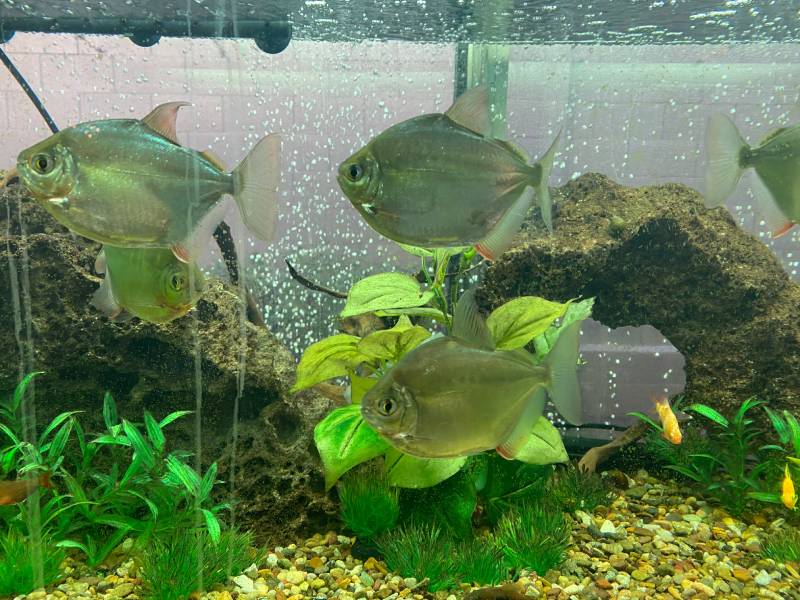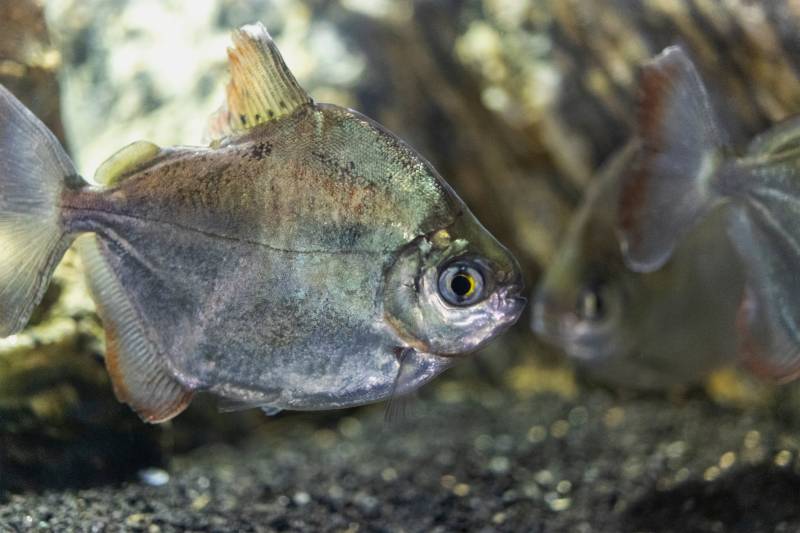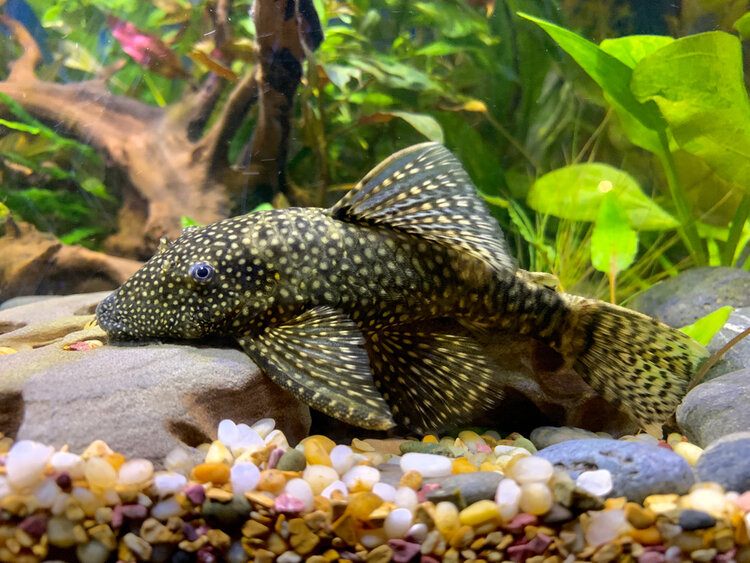Silver Dollar Fish: Care Guide, Varieties & Lifespan (With Pictures)

Updated on

The Silver Dollar is perhaps one of the most fascinating freshwater fish. Although they are not very colorful, Silver Dollar Fish have a unique appearance and peaceful temperament. These qualities make them popular fish for large, tropical aquariums.
While beginner fish keepers might be able to keep Silver Dollar Fish, they are better suited for those with more experience. This is mainly because Silver Dollars can be sensitive to changes in their environment. They also need specific care requirements to thrive in captivity. Regardless, Silver Dollars can be a fantastic addition to many large tropical aquariums.
Quick Facts About Silver Dollar Fish
| Species Name: | Metynnis argenteus |
| Family: | Characidae |
| Care Level: | Moderate |
| Temperature: | 75°F to 82°F |
| Temperament: | Peaceful, timid, and social |
| Color Form: | Silver, red, blue, orange, yellow, and black |
| Lifespan: | 8 to 10 years |
| Size: | 6 to 8 inches |
| Diet: | Omnivore |
| Minimum Tank Size: | 75 gallons |
| Tank Set-Up: | Tropical, planted, freshwater |
| Compatibility: | Community aquariums |
Silver Dollar Fish Overview
There are over ten different species of Silver Dollar Fish in the Metynnis genus that can be kept in aquariums. The most popular species is the M. argenteus, followed by the M. hypsauchen. Both species belong to the Characidae family and are native to South America. Each species of Silver Dollar Fish has similar care requirements.
The main differences between each species would be their appearance and not their size or lifespan. There are also Silver Dollar Fish from the Myloplus genus, and they usually have more impressive colorations.

Silver Dollar Species
- Common Silver Dollar (M. argenteus)
- Spotted Silver Dollar (M. lippincottianus)
- Schreitmuller’s Silver Dollar (M. hypsauchen)
- Striped Silver Dollar (M. fasciatus)
- Speckled Silver Dollar (M. masculatus)
- Red hook Silver Dollar (M. rubripinnis)
- Black-barred Silver Dollar (M. schomburgkii)
Silver Dollars inhabit the Amazon River Basin in Brazil, the Peru and Guyana waterways, along with river systems in Bolivia. They prefer warm rivers and streams with muddy bottoms and dense vegetation. In the wild, Silver Dollars form large schools and are active swimmers. Their flat and wide-shaped bodies that resemble the Silver Dollar coined they are named after are popular amongst fish keepers.
Although Silver Dollar Fish belong in the same family as piranhas, they are relatively peaceful fish that are more on the timid side.
How Much Do Silver Dollar Fish Cost?
Silver Dollar Fish can range in price depending on their species, age, and size. Most Silver Dollar Fish are sold for around $8 to $25 in a pet store. Larger Silver Dollars can be priced as high as $35 in some cases. The rarer species of Silver Dollar Fish are typically much more expensive, but they rarely cost more than $60. Since Silver Dollars are often bought in groups, you might be able to get them for a discounted price depending on where you purchase them from.

Typical Behavior & Temperament
The Silver Dollar is not considered a territorial species, and they are usually mellow and social. Silver Dollars are quite active when they are kept in large groups and can be seen swimming around all parts of an aquarium. They are lively schooling fish that can be kept in communal aquariums and generally don’t have other fish.
When first introduced into aquariums, kept alone or in pairs, Silver Dollars can be shy and spend most of their time hiding. Keeping them in the right conditions and in groups of five or more encourages Silver Dollars to be more active.
Appearance & Varieties
Silver Dollars are medium size fish and reach an adult size of 6 to 8 inches. Most species of Silver Dollar Fish rarely grow larger than 6 inches, but it is not unheard of. Silver Dollars can take a while to reach their full size, usually throughout 1–3 years.
They have a silverish body coloration that can either have spots, stripes, or colorful markings, depending on their species. Their bodies are pancake-like with a large anal fin and dorsal fin. All Silver Dollars have two eyes on either side of their heads. Their mouths are quite small despite their size. Their silverish bodies are reflective, which only adds to their striking appearance.
Striped Silver Dollars usually have black stripes like a tiger that form along their fins and body. Some Silver Dollars can have a yellowish-brown coloration with spotting as well. The Red Hook Silver Dollar has a distinctive red anal fin, while the common Silver Dollar is entirely silver or grey.

How to Take Care of Silver Dollar Fish
Habitat, Tank Conditions & Setup
Caring for Silver Dollars is moderately difficult, so experienced fish keepers may find it easier to care for these fish.
Tank Size
For a group of five Silver Dollars, you would need to keep the adults in at least a 75-gallon tank. Silver Dollars need to be kept in groups since they are social fish, so you can’t keep them alone in small tanks. They need a spacious rectangular tank to grow, swim comfortably, and form schools. If you are keeping Silver Dollar fry or juveniles, they can be kept in a 55-gallon grow-out tank until they can be moved to a larger one.
Unfortunately, Silver Dollar Fish cannot be kept in bowls, vases, or outdoor ponds.
Water Quality & Conditions
Silver Dollar Fish are sensitive to aquarium water conditions, and don’t adapt well to sudden changes in its chemistry or temperature. As tropical freshwater fish, Silver Dollars need a heater in their aquarium. You will need to ensure that their aquarium has no traces of ammonia and nitrite which are deadly for Silver Dollars.

| Temperature | 75 to 82 degrees Fahrenheit |
| pH range | 5 to 7.5 |
| Water hardness | 4 to 15 dGH |
| Ammonia | 0 ppm |
| Nitrite | 0 ppm |
| Nitrate | 20 ppm |
Substrate
Silver Dollars naturally inhabit waters with sandy or muddy bottoms. Therefore, they benefit from having a similar substrate in aquariums. Although you can use gravel or pebbles in your Silver Dollars aquarium, sand is preferred.
Plants
Plants are favored for Silver Dollars aquariums because they replicate the dense vegetation Silver Dollars experience in the wild. Live plants such as Hornwort, Anubias, and various floating plants can be a great addition to Silver Dollar aquariums.

Lighting
If you have live plants in your Silver Dollars aquarium, a low to moderate light will be useful. Silver Dollars shouldn’t be kept in darkness all day, and benefit from having a light on for up to 8 hours. However, Silver Dollars aren’t fond of bright lighting, and it may cause them to hide more often.
Filtration
A filter is a must-have for Silver Dollars. The filter will keep the water quality clean and help process their waste. A filter that does not produce a strong current from the output is recommended. Silver Dollars don’t enjoy swimming against fast currents, which can stress them out.
Are Silver Dollars Good Tank Mates?
Silver Dollars are some of the best schooling fish you can keep in community aquariums. They get along well with many different tank mates and rarely show aggression to other fish. Silver Dollars make good tank mates for other peaceful and tropical fish that have similar water requirements. You want to avoid keeping Silver Dollars with large and aggressive fish. These types of fish do not mix well with Silver Dollars and can injure them.
Furthermore, aggressive fish can cause unnecessary stress to your Silver Dollars which may make them more susceptible to disease.
Let’s look below at the best and worst tank mates for Silver Dollars:
- Plecostomus
- Cory catfish
- Mystery snails
- Kuhli loaches
- Red empress
- Giant gourami
- Angelfish
- Blue rams
- Goldfish
- Koi
- Jack Dempsey
- Neon tetras
- Betta fish
- Guppies
- Mollies and other livebearers
- Shrimp and small invertebrates
Overall, the best tank mates for Silver Dollars will be peaceful bottom-dwelling fish like Plecos and Cory Catfish.

What to Feed Your Silver Dollar
Silver Dollars have earned the nickname “herbivore piranhas” because although they belong to the same family, Silver Dollars eat a lot of plants. They are omnivores but will generally eat anything in an aquarium. A Silver Dollar’s primary diet should consist of high-quality flakes or pellets. This should be fed to them once or twice a day, and only as much as they can eat within 5 minutes. You can also include supplements in their diet in the form of live or freeze-dried foods, or algae wafers. Spirulina flakes are also favored by Silver Dollars while being nutritious.
Keeping Your Silver Dollar Healthy
Keeping your Silver Dollars healthy can be tricky, especially if you are a new fish keeper. Silver Dollars aren’t hardy fish and don’t tolerate sudden water changes. The most important factor to consider when keeping Silver Dollars healthy is their water quality. Silver Dollars require warm water with slightly acidic water. Both their temperature and pH range shouldn’t fluctuate as this can stress your fish.
The water will need to be regularly tested for ammonia and nitrite, which are only safe for these fish at 0 ppm. Even the slightest traces of ammonia and nitrite can be detrimental to Silver Dollars. Weekly water changes are recommended to keep the water in good condition. However, you want to avoid doing large water changes on your Silver Dollars aquarium too often.
Breeding
It is easy to breed Silver Dollars in captivity if they are provided with the right spawning conditions. Silver Dollars are egg-layers and will spawn in warm, soft water conditions. To increase the success rate of your Silver Dollars spawning, you should keep them in male and female groups of six or more. Ideally, you want to keep more females than males.
They prefer having plant spawning material to safely deposit their eggs. Male Silver Dollars can be distinguished from females by their longer anal fins which are tinged red. Most Silver Dollars will breed at around 1 to 2 years of age. Once fertilized, Silver Dollar eggs will hatch within 2–3 days.

 Are Silver Dollar Fish Suitable for Your Aquarium?
Are Silver Dollar Fish Suitable for Your Aquarium?
If you are a more experienced fish keeper looking for a shiny, peaceful, and social schooling fish, the Silver Dollar might be right for you. You want to ensure that they are kept in large tanks that can support a group of five or more. They need their water to be heated and contain a sandy substrate with live plants. Silver Dollars also make good community fish if they are kept with other peaceful fish.
When kept in a well-maintained aquarium with the ideal water parameters, Silver Dollars can live for up to 10 years.
Featured Image Credit: boban_nz, Shutterstock











